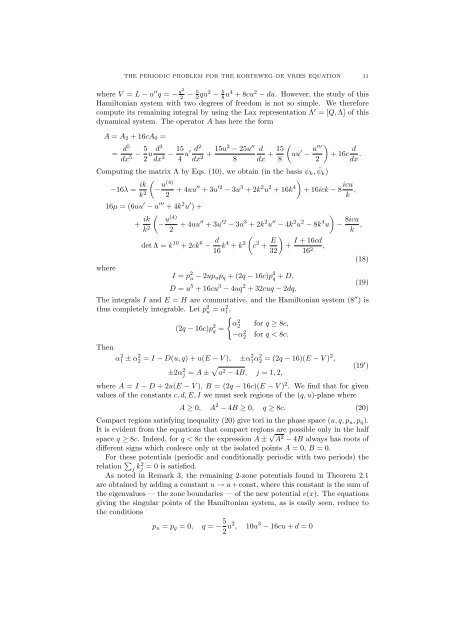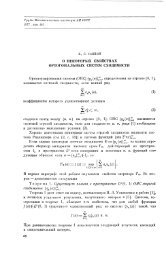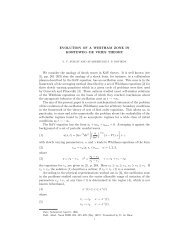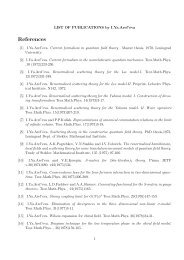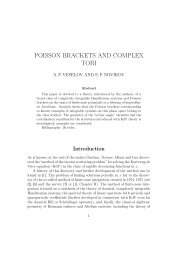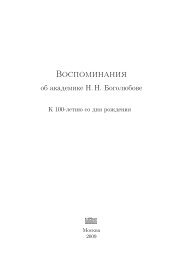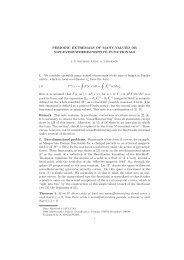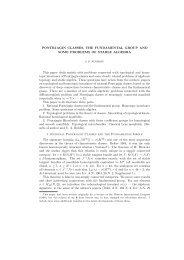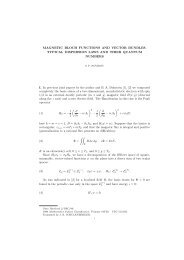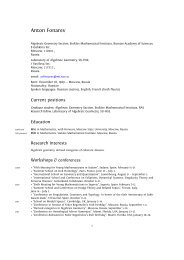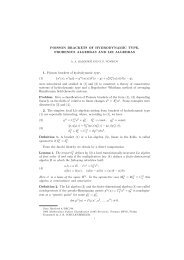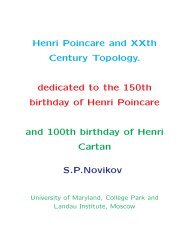A periodic problem for the Korteweg-de Vries equations, I.
A periodic problem for the Korteweg-de Vries equations, I.
A periodic problem for the Korteweg-de Vries equations, I.
Create successful ePaper yourself
Turn your PDF publications into a flip-book with our unique Google optimized e-Paper software.
THE PERIODIC PROBLEM FOR THE KORTEWEG–DE VRIES EQUATION 11where V = L − u ′′ q = − q22 − 5 2 qu2 − 5 8 u4 + 8cu 2 − du. However, <strong>the</strong> study of thisHamiltonian system with two <strong>de</strong>grees of freedom is not so simple. We <strong>the</strong>re<strong>for</strong>ecompute its remaining integral by using <strong>the</strong> Lax representation Λ ′ = [Q, Λ] of thisdynamical system. The operator A has here <strong>the</strong> <strong>for</strong>mA = A 2 + 16cA 0 == d5dx 5 − 5 2 u d3dx 3 − 15 d2u′4 dx 2 + 15u2 − 25u ′′ d8 dx + 15 8)(uu ′ − u′′′+ 16c d2 dx .Computing <strong>the</strong> matrix Λ by Eqs. (10), we obtain (in <strong>the</strong> basis ψ k , ¯ψ k )−16λ = ik ()k 2 − u(4)2 + 4uu′′ + 3u ′2 − 3u 3 + 2k 2 u 2 + 16k 4 + 16ick − 8 icuk ,16µ = (6uu ′ − u ′′′ + 4k 2 u ′ ) ++ ik ()k 2 − u(4)2 + 4uu′′ + 3u ′2 − 3u 3 + 2k 2 u ′′ − 4k 2 u 2 − 8k 4 u<strong>de</strong>t Λ = k 10 + 2ck 6 − d (16 k4 + k 2 c 2 + E )+ I + 16cd32 16 2 ,whereI = p 2 u − 2up u p q + (2q − 16c)p 2 q + D,D = u 5 + 16cu 3 − 4uq 2 + 32cuq − 2dq.− 8icuk ,The integrals I and E = H are commutative, and <strong>the</strong> Hamiltonian system (8 ′′ ) isthus completely integrable. Let p 2 u = α1,2{(2q − 16c)p 2 α2 2 <strong>for</strong> q ≥ 8c,q =−α2 2 <strong>for</strong> q < 8c.Thenα 2 1 ± α 2 2 = I − D(u, q) + u(E − V ), ±α 2 1α 2 2 = (2q − 16)(E − V ) 2 ,±2α 2 j = A ± √ a 2 − 4B, j = 1, 2,(18)(19)(19 ′ )where A = I − D + 2u(E − V ), B = (2q − 16c)(E − V ) 2 . We find that <strong>for</strong> givenvalues of <strong>the</strong> constants c, d, E, I we must seek regions of <strong>the</strong> (q, u)-plane whereA ≥ 0, A 2 − 4B ≥ 0, q ≥ 8c. (20)Compact regions satisfying inequality (20) give tori in <strong>the</strong> phase space (u, q, p u , p q ).It is evi<strong>de</strong>nt from <strong>the</strong> <strong>equations</strong> that compact regions are possible only in <strong>the</strong> halfspace q ≥ 8c. In<strong>de</strong>ed, <strong>for</strong> q < 8c <strong>the</strong> expression A ± √ A 2 − 4B always has roots ofdifferent signs which coalesce only at <strong>the</strong> isolated points A = 0, B = 0.For <strong>the</strong>se potentials (<strong>periodic</strong> and conditionally <strong>periodic</strong> with two periods) <strong>the</strong>relation ∑ j k2 j = 0 is satisfied.As noted in Remark 3, <strong>the</strong> remaining 2-zone potentials found in Theorem 2.1are obtained by adding a constant u → u + const, where this constant is <strong>the</strong> sum of<strong>the</strong> eigenvalues — <strong>the</strong> zone boundaries — of <strong>the</strong> new potential v(x). The <strong>equations</strong>giving <strong>the</strong> singular points of <strong>the</strong> Hamiltonian system, as is easily seen, reduce to<strong>the</strong> conditionsp u = p q = 0, q = − 5 2 u2 , 10u 3 − 16cu + d = 0


